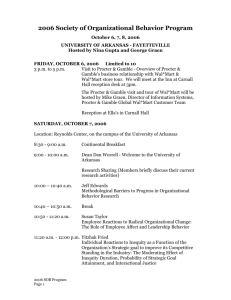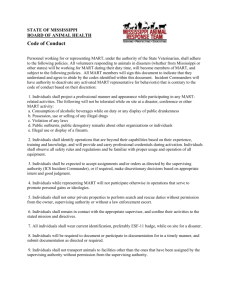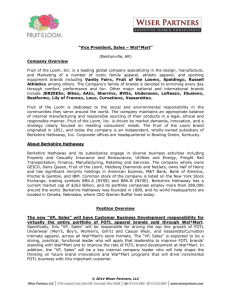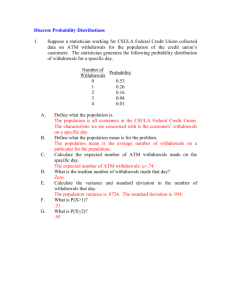The Local Costs and Benefits of Wal-Mart
advertisement
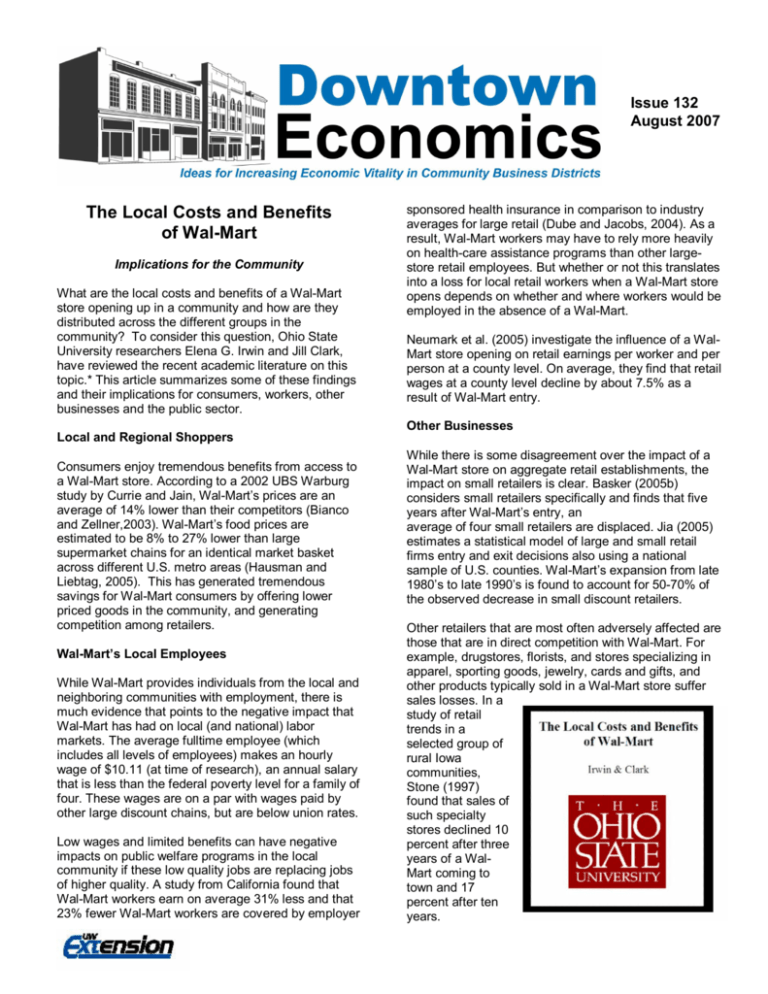
Issue 132 August 2007 The Local Costs and Benefits of Wal­Mart Implications for the Community What are the local costs and benefits of a Wal­Mart store opening up in a community and how are they distributed across the different groups in the community? To consider this question, Ohio State University researchers Elena G. Irwin and Jill Clark, have reviewed the recent academic literature on this topic.* This article summarizes some of these findings and their implications for consumers, workers, other businesses and the public sector. Local and Regional Shoppers Consumers enjoy tremendous benefits from access to a Wal­Mart store. According to a 2002 UBS Warburg study by Currie and Jain, Wal­Mart’s prices are an average of 14% lower than their competitors (Bianco and Zellner,2003). Wal­Mart’s food prices are estimated to be 8% to 27% lower than large supermarket chains for an identical market basket across different U.S. metro areas (Hausman and Liebtag, 2005). This has generated tremendous savings for Wal­Mart consumers by offering lower priced goods in the community, and generating competition among retailers. Wal­Mart’s Local Employees While Wal­Mart provides individuals from the local and neighboring communities with employment, there is much evidence that points to the negative impact that Wal­Mart has had on local (and national) labor markets. The average fulltime employee (which includes all levels of employees) makes an hourly wage of $10.11 (at time of research), an annual salary that is less than the federal poverty level for a family of four. These wages are on a par with wages paid by other large discount chains, but are below union rates. Low wages and limited benefits can have negative impacts on public welfare programs in the local community if these low quality jobs are replacing jobs of higher quality. A study from California found that Wal­Mart workers earn on average 31% less and that 23% fewer Wal­Mart workers are covered by employer sponsored health insurance in comparison to industry averages for large retail (Dube and Jacobs, 2004). As a result, Wal­Mart workers may have to rely more heavily on health­care assistance programs than other large­ store retail employees. But whether or not this translates into a loss for local retail workers when a Wal­Mart store opens depends on whether and where workers would be employed in the absence of a Wal­Mart. Neumark et al. (2005) investigate the influence of a Wal­ Mart store opening on retail earnings per worker and per person at a county level. On average, they find that retail wages at a county level decline by about 7.5% as a result of Wal­Mart entry. Other Businesses While there is some disagreement over the impact of a Wal­Mart store on aggregate retail establishments, the impact on small retailers is clear. Basker (2005b) considers small retailers specifically and finds that five years after Wal­Mart’s entry, an average of four small retailers are displaced. Jia (2005) estimates a statistical model of large and small retail firms entry and exit decisions also using a national sample of U.S. counties. Wal­Mart’s expansion from late 1980’s to late 1990’s is found to account for 50­70% of the observed decrease in small discount retailers. Other retailers that are most often adversely affected are those that are in direct competition with Wal­Mart. For example, drugstores, florists, and stores specializing in apparel, sporting goods, jewelry, cards and gifts, and other products typically sold in a Wal­Mart store suffer sales losses. In a study of retail trends in a selected group of rural Iowa communities, Stone (1997) found that sales of such specialty stores declined 10 percent after three years of a Wal­ Mart coming to town and 17 percent after ten years. On the other hand, sales associated with eating and drinking establishments can experience a boost. In the same Iowa study, Stone (1997) found that total sales of local restaurants and other eating and drinking establishments had increased an average of five percent ten years after a Wal­Mart opening. Because Wal­Mart stores require large parcels of land, they tend to locate at the edges of a town and thus may divert traffic away from traditional downtown shopping areas. This can have clear negative effects on the traditional “Main Street” shopping district while bringing benefits to complementary stores located on the fringes. Local Jurisdiction: Revenues and Expenditures A new Wal­Mart can stimulate total retail sales within a community by attracting customers from further away and thus, the local jurisdiction benefits through higher sales tax revenues. However, this depends on the regional distribution of Wal­Mart and other large retail stores and how much of an increase in the local market area a new Wal­Mart store is able to achieve. Whether an area’s total retail sales increase also depends on the extent to which Wal­Mart attracts additional retail dollars to the local shopping district vs. simply replacing the sales of existing businesses. Lower prices make it more likely that the existing customer base will spend more money on retail goods, thus increasing the total retail sales in a local community without increasing the number of consumers. However, the magnitude of this effect depends on how responsive consumers are to the price changes of specific products. In addition to impacts on local tax revenues, a Wal­ Mart store may generate greater fiscal costs to a community than it generates in revenue, thereby being a drain on fiscal resources. Wal­Mart and other supercenters typically locate in outer suburban areas, which exacerbates the fiscal costs associated with traffic congestion and infrastructure strain. Local Jurisdiction: Greater Social Costs Some studies have found a positive correlation between Wal­Mart stores and poverty/increased reliance on public assistance programs. In California, Wal­Mart employees use an estimated 38 percent more in public assistance programs (e.g., food stamps and subsidized school lunches) than the average for families of all large­store retail employees (Dube and Jacobs, 2003). A recent national study of these additional social costs estimates that the average Wal­ Mart employee costs federal taxpayers an extra $2,103 (Democratic Staff, Comm. on Education and the Workforce, U.S. House of Representatives, Rep. G. Miller, DCA). While these results are suggestive, they are based on strong assumptions. The extent to which retail workers are worse off working at a Wal­Mart store of course depends on what the alternatives would have been for these workers in the absence of Wal­Mart. Local Environment Wal­Mart stores are expansive, single story buildings that are accompanied by equally expansive, paved parking lots. Because of extensive paving, major drainage problems can occur, leading to flooding and ground­carving. Its fringe location has spurred associations of Wal­Mart with “sprawl” development and increased traffic congestion. However, these traits appear to be a ubiquitous characteristic of new retail development and are not specific to Wal­Mart. Neighboring communities Because Wal­Mart challenges traditional retailers on price and often convenience, it typically pulls customers from a larger market region. Neighboring communities are likely to experience increased retail leakages in some retail sectors as consumers are willing to drive farther for lower prices and the convenience of one­stop shopping. Stone (1997) found the trends for retailers located in Non­Wal­Mart neighboring towns to be consistent with this logic. Ten years after a Wal­Mart opening, total retail sales in neighboring non­Wal­Mart towns were 15 percent lower (Stone, 1997). Summary There are definite costs and benefits associated with Wal­Mart and that these costs and benefits are unevenly distributed across Wal­Mart employees, shoppers and the local communities that are affected by Wal­Mart. The clear winners are the consumers who are able to enjoy Wal­Mart’s low prices. The clear losers are the existing businesses from local and neighboring communities that are driven out of business because they simply cannot compete with Wal­Mart. Communities must also consider issues such as local tax benefits, impact on local employment opportunities, potential increase in poverty, traffic congestion and local infrastructure costs. * This article is from a report titled The Local Costs and Benefits of Wal­Mart by Elena G. Irwin, Associate Professor and Jill Clark, Program Manager, Department of Agricultural, Environmental and Development Economics, The Ohio State University. For a copy of the full report: http://aede.osu.edu/programs/ComRegEcon/walmart.htm . Contact: Bill Ryan, Center For Community & Economic Development, University of Wisconsin­Extension 610 Langdon Street, Madison, WI 53703­1104 PH: (608)265­8136; FAX: (608)263­4999; TTY: (800)947­3529; HTTP://WWW.UWEX.EDU/CES/CCED An EEO/Affirmative Action Employer, UW­Extension provides equal opportunities in employment and programming, including Title IX and ADA requirements.

